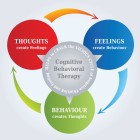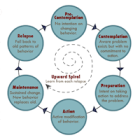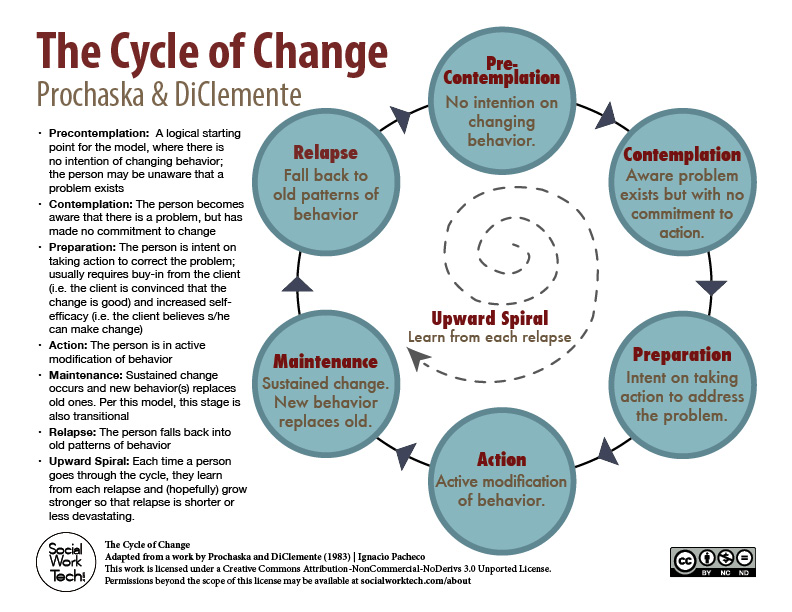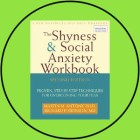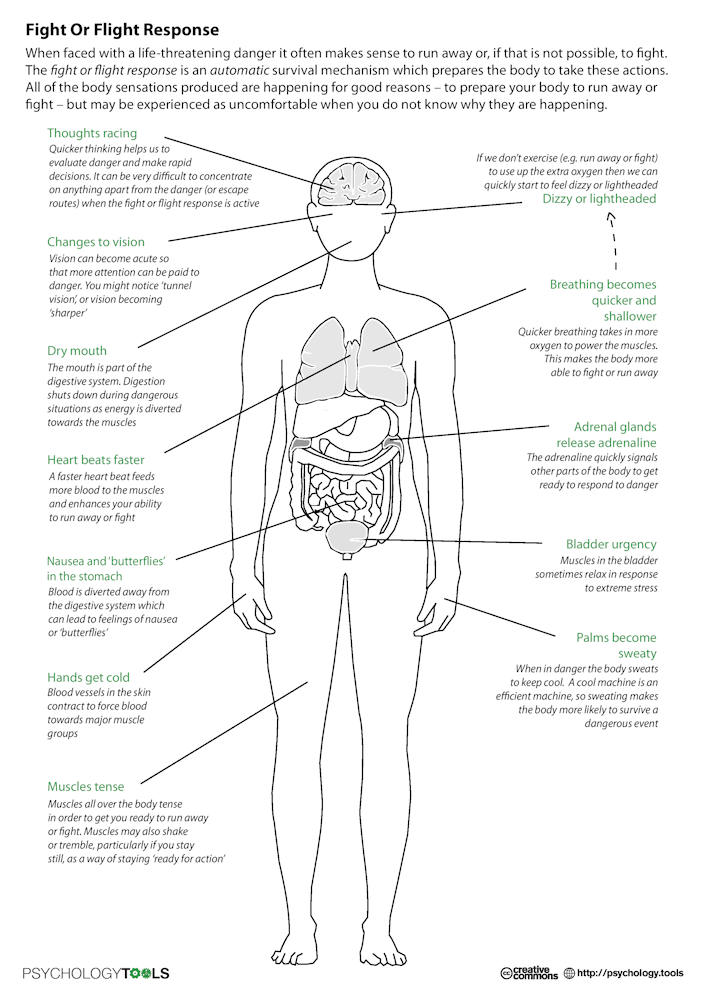Tag Archives:CBT
Illustration of (Some) CBT Concepts share
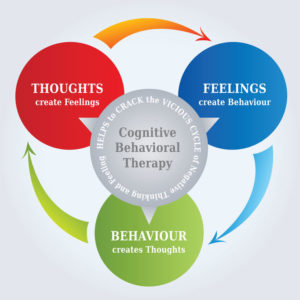 Overview
Overview
Cognitive Behavioral Therapy (CBT) is the strongest, research-backed therapeutic approach in the treatment of anxiety and, additionally, to be very effective for a whole host of other mental health issues. It is based on the framework that emotions, thoughts, and body sensations/physical behavior are at three points of a triangle and intervening on one of the points will result in changes the other two.
TEDx Talk: Feeling Good presented by David Burns, MD – In this YouTube video, David Burns, MD, a well known researcher, clinician, and educator introduces the power of CBT in his warm, humorous and down-to-earth way.
Concepts
“Automatic Thoughts”
Automatic thoughts are a core concept of CBT. They are our brain’s running interior dialogue or self-talk that narrates our life without us even really being aware of that it’s happening until we choose to pay attention to them. If your thoughts frequently contain “thought errors” that are biased to being negative ones, they are very likely to be increasing the level of anxiety or depression that you feel necessarily . These thoughts are habits that reflect the way we interpret things that we do, experience, or even how we view the world. The thing about habits is that, with some work, they can be shifted or changed. When you increase awareness of what your automatic thoughts are, you can start to challenge them and then, ultimately, reduce their effect on your perceptions and your mood. When working with children, negative automatic thoughts that affect them this can sometimes be referred to as a “brain bully.”
- An animated video that talks about automatic thoughts and gives an overview of some of the typical “thought errors” that people might have. Read More >
Thought Errors/Cognitive Distortions
“Focus on the Negative”
Focusing on the negative is known in CBT as a cognitive distortion or “thought error” that can increase the level of anxiety or depression that you feel. The human brain is drawn to negatives but it skews our perception of people and the world around us. With the easy access to negativity in the media, including the internet, it can be more and more challenging to pull our minds away and, instead, choose to focus on the wealth of positive things in our lives. However, the research shows that with practice we can get better at recognizing when we are focusing on only the negative aspects of something and then consciously remind ourselves of all of the positives in the situation instead.
- A playful animated video that illustrates this idea. Read More >
- TED talk that gives a more scientific explanation of how our brains seem to stay stuck on negative information, and how to get unstuck. Read More >
- Story time! At least that’s what our brain is doing when we are experiencing fear for something that might happen in the future. Check out this TED talk and learn more. Hmmm…why might this knowledge be important? Read More >
Stages of Change share
Once upon a time there were two researchers, Prochaska & DiClemente. (If you can’t already tell, I’m in a bit of a silly mood at the moment.) They were smart people who did research and read other people’s research and put it all together back in 1983 to come up with their Stages of Change model. This model is used heavily in the treatment of addictions but can also be applied to things like the treatment of anxiety and depression…or almost anything really, where change is involved. What they so wisely realized, when it came to making a change in one’s life, was that in addition to understanding the human mind and what can help it to change, you also need to be aware of the person’s readiness to actually do the work to make the change that they are looking for. The stages are Pre-Contemplation (when you don’t even have the desire to make a change), Contemplation (when you recognize that there is a problem and you are starting to consider if you want to make a change), Preparation (when you are starting to gather the resources and information you might need to help you make this change), Action (actively working on making the change happen), and Maintenance (you’ve made the change and can finally start to not work so hard on it, but there may still be some things you need to do to keep this positive change in place).
The Stages of Change model can help us to be patient with ourselves. It can help us to recognize how really ready we (or someone we care about) might actually be to make a significant change in our life. And, it can help us to realize what steps we can take to get ourselves closer to being ready to make this change. There is a therapeutic approach, Motivational Interviewing, that is also heavily rooted in the treatment of addictions but that can be applied in all sorts of other places. Motivational Interviewing is a technique that helps therapists, parents, even friends, to be accepting of the stage of change that a person is in at this moment, and being able to work with them (rather than battle with them) to explore small steps that they might feel comfortable with doing that will get them closer to being ready for change. (I plan to make a post on that at some point but for now, I leave you with doing an internet search.)
Below is an illustration of these stages. I like this illustration in particular because it’s drawn with a spiral rather than in a linear way. This is because there are no rules about the actual order we need to go in as we head towards change. And, sometimes, we even go backwards to an “earlier” level.
Shyness and Social Anxiety Workbook: Proven, Step-by-Step Techniques for Overcoming your Fear by Martin M. Antony PhD and Richard Swinson MD FRCPC FRCP share
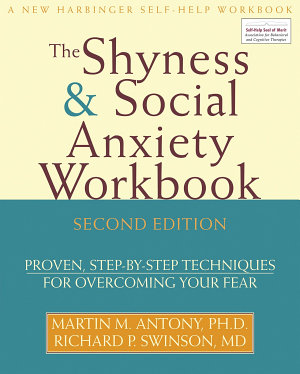 I recommend using this book when working with adults and some teens who have high levels of shyness and social anxiety. In a clear, and easy to read fashion, this book takes you step-by-step through the process of learning about how cognitive behavioral therapy (CBT) views shyness and social anxiety and is a powerful tool in overcoming how these thoughts and feelings can hold you back from living your life in a way that you are comfortable and happy with. CBT is a therapeutic philosophy and a large body of scientific research strongly supports CBT as the foremost treatment of social anxiety.
I recommend using this book when working with adults and some teens who have high levels of shyness and social anxiety. In a clear, and easy to read fashion, this book takes you step-by-step through the process of learning about how cognitive behavioral therapy (CBT) views shyness and social anxiety and is a powerful tool in overcoming how these thoughts and feelings can hold you back from living your life in a way that you are comfortable and happy with. CBT is a therapeutic philosophy and a large body of scientific research strongly supports CBT as the foremost treatment of social anxiety.
I do think that most people would still need a therapist to be guiding them through the process because for the individual working to learn these skills and challenging themselves to try new things, it can take a lot of energy. When a therapist is coaching you in the sidelines (and celebrating your successes with you), it frees you up to devote all of your energy towards growing. However, over time, these are skills that you will learn and can take with you forever. Once you understand how it works and how powerful it is, you will be able to use this approach to tackle any similar issues that should come up for you in the future.
As a therapist, I don’t use this book alone. I supplement it with concrete, scientifically grounded information about relaxation breathing, Growth Mindset as well as other customized handouts and tally sheets for homework.
TEDx UC Davis: Getting Stuck in the Negatives (and how to get unstuck) presented by Alison Ledgerwood, PhD (video) share
Dr. Ledgerwood’s research show us that our brains are hardwired to subconsciously focus on negative information, despite positive information to the contrary. However, when we make a conscious decision to shift our focus to positive things…things that are already there but our brains just having been paying attention to them, we can change our view of the world and of ourselves.
TEDx Talk: Feeling Good presented by David Burns, MD share
Cognitive Behavioral Therapy (CBT) is based on the premise that our thoughts, emotions, and behavior are all interrelated and affect one another. Because of this, if we learn to identify when we are having “thought errors” that distort our perception of reality, often skewing to seeing things in more a negative light, we can then Dr. David Burns is a well known researcher, clinician, and public speaker. He is one of the leaders in the development of CBT, having been trained personally by CBT’s founder, the world-renowned Aaron T. Beck, MD. In this short video, Dr. Burns uses stories from his life experience both as a clinician and as a person, to illustrate the power of CBT and how working to change our thoughts, in a real and genuine way, can have a profoundly positive effect on how we feel. CBT has become the strongest (most likely to succeed), “evidence-based” form of therapy for issues such as depression and Bipolar Disorder, various forms of anxiety (PTSD, phobias, Obsessive-Compulsive Disorder), eating disorders, and substance use disorders. This means that scientific research has been able to document that CBT really works for people.
Panic & Time Magazine's "How to Increase Mental Toughness: 4 Secrets From Navy SEALs and Olympians" by Eric Barker share
Panic. Our body’s ability to prime itself for a life-saving level of physical response, “fight or flight,” is a gift. It allows us to summon every possible physical resource we have to save ourselves from a physical threat. But, when the threat is imagined or emotional, it feels really yucky to be in physical panic mode. This is especially true because our bodies, in that moment, experience temporary physical changes (i.e. increased heart rate, quick & shallow breathing, increased blood circulation to muscles, decreased blood circulation to the “rational” part of your brain, etc. Click image on the right for more details.) that can feel scary if we don’t understand why it’s happening. However, our body naturally knows how to shift out of this mode when the perception of the threat is gone. Of course, because being in that high alert mode has our body burning off a great deal of our energy in a short amount of time, we’re left feeling exhausted in the aftermath, even if we didn’t actually fight or flee.
(If you can’t see the embedded video at the top of this page, click on the following link for the article and scroll down to the second video on the page that’s titled, “Navy SEALs Mental Training.”) The video displayed at the top of this page and accompanying article explains our body’s normal fight, flight, or freeze response and ways that the Navy SEALs and Olympic athletes train to have as much control as possible over preventing their bodies from triggering this response when they don’t want it.
Emphasis is on understanding the biology behind what is happening in our bodies when we experience fear and then using four basic skills to help our minds not be unnecessarily controlled by fear and panic:
- Positive Self-Talk
- Goal Setting
- Practice Visualization
- Use Simulations (practice)
All of these techniques are key components to CBT (Cognitive and Behavioral Therapy) and are used in therapy sessions with clients every day to treat both excessive anxiety as well as depression. And, if you struggle with “panic attacks”, the fight, flight, or freeze response is technically what is happening in your body (this involves the amygdala, hypothalamus, and adrenaline). It is a normal body function that is being triggered when there is the perception of a threat and prepares us to cope with life threatening situations. However, when it comes to fear, our minds don’t differentiate between physical threats and mental/emotional threats. But, the reality is that that the fight, flight, or freeze response isn’t very helpful when it comes to dealing with mental/emotional threats. So, the better we can use coping skills to prevent ourselves from the panicking, the more success we will have in coping with the challenges we face.
The video also mentions using relaxation breathing as the primary method of quickly recovering from when our fight, flight, or freeze response has been triggered. It talks about how particularly long exhales mimic our body’s normal relaxation mode (which is a new idea for me, I’ll have to find the time to look into the research on that point) and that the increase in oxygen in the bloodstream helps get the more logical, frontal cortex of the brain re-engaged so that you can think through your situation more rationally.
So, the next time you happen to be working on improving your CBT skills, just remember that if it works for the intense challenges that Navy SEALs and Olympic athletes face during actual physical threats, with practice, it will work for you when you’re working on not freaking out about having to do something in every day life like public speaking or taking a trip to the grocery store.
What to Do When Your TEMPER FLARES by Dawn Huebner, PhD share
 This is a fabulous workbook for kids. The book suggests using it from ages 6-12 but I think that is a loose guide and depends on the mindset of the child as well as their ability to understand that other people’s thoughts can be different than their own. Using fire as a metaphor for anger, the words and pictures then walk the reader through several different skills and approaches that can help a person develop a “longer fuse.” Explanations are concrete, using visual metaphors and practice to help increase skills that are very effective in managing anger. The author teaches, among other things, how our inner thoughts can affect our feelings and that if we work to adjust our thinking and give situations more of the benefit of the doubt,
This is a fabulous workbook for kids. The book suggests using it from ages 6-12 but I think that is a loose guide and depends on the mindset of the child as well as their ability to understand that other people’s thoughts can be different than their own. Using fire as a metaphor for anger, the words and pictures then walk the reader through several different skills and approaches that can help a person develop a “longer fuse.” Explanations are concrete, using visual metaphors and practice to help increase skills that are very effective in managing anger. The author teaches, among other things, how our inner thoughts can affect our feelings and that if we work to adjust our thinking and give situations more of the benefit of the doubt,
I use this book in session with some of my clients. Parents can also use this on their own with their kids and there is an introduction in the beginning of the book to help guide parents through how to approach it. With a positive, supportive approach you can really deepen your relationship with your child by being a resource that can help him or her to work through these challenges.
* I don’t make any money from the books that I recommend. My reviews are solely based on wanting to let people know what’s out there and could be helpful to them.

